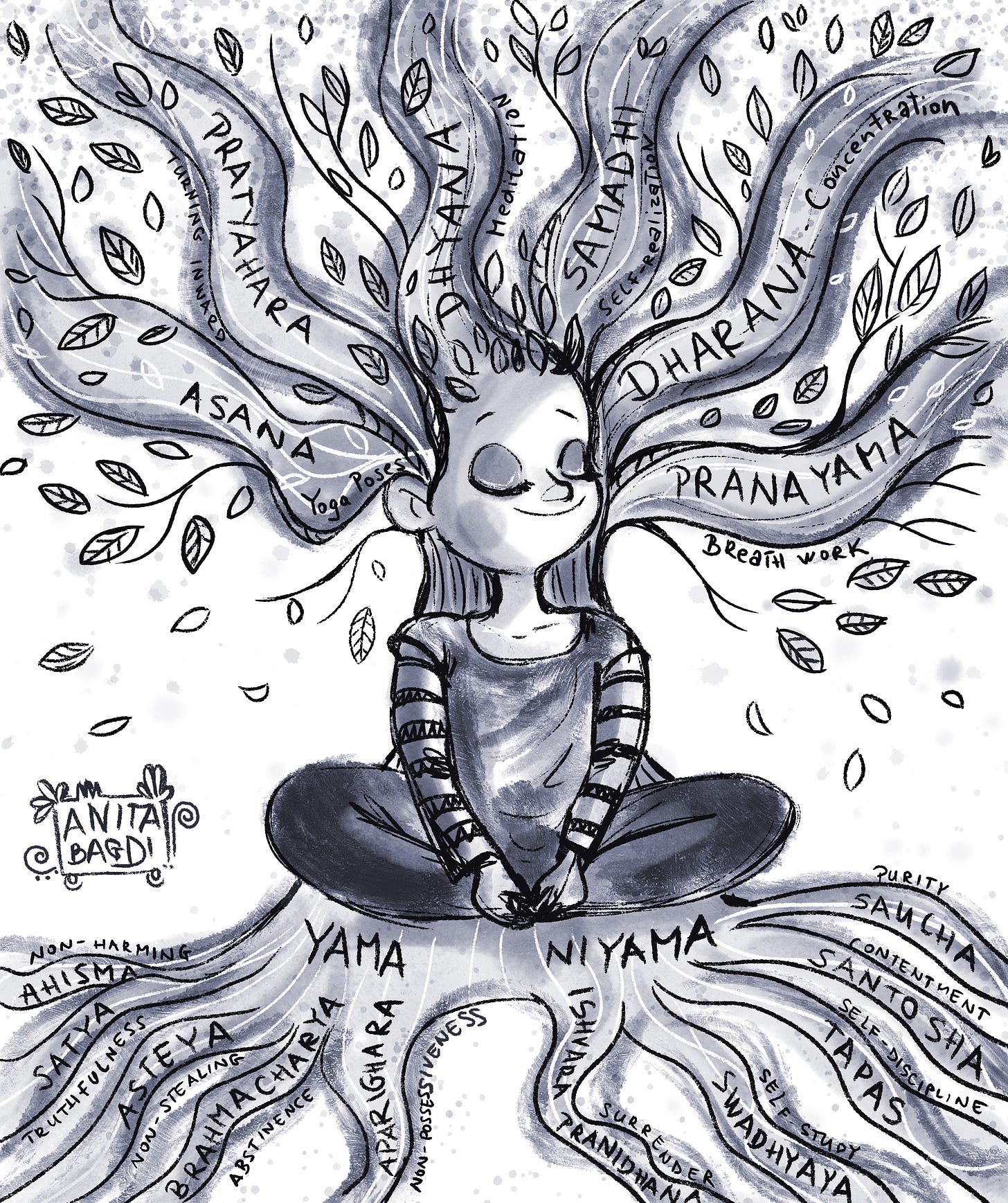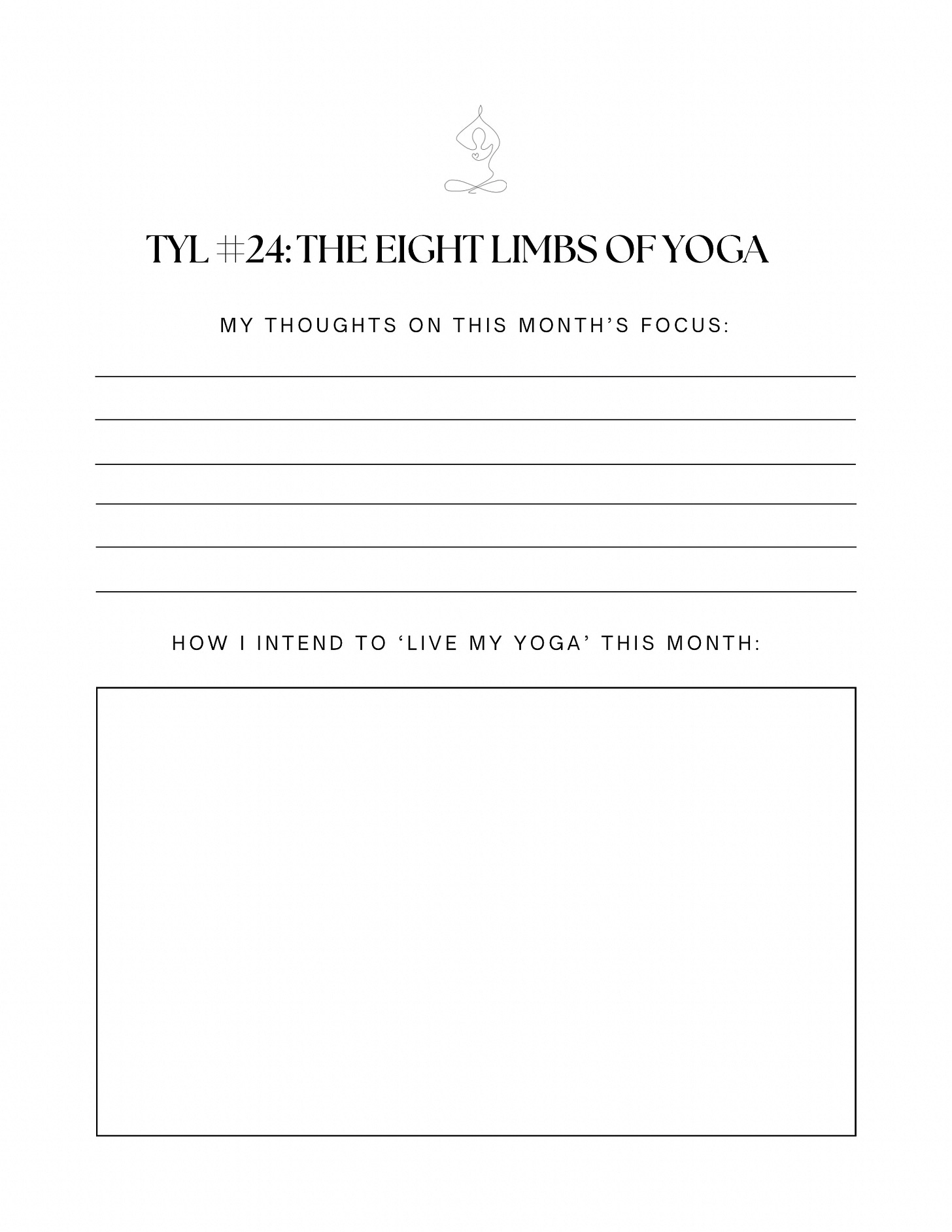The Yoga Sutras is an ancient Indian text that has been read by countless yoga practitioners, and the main piece of wisdom that it bestows is that the human mind is an entity that requires our full attention.
Not least so we can live more peacefully, both internally - within ourselves - and externally, in how we interact with the world around us.
I think it is really important to highlight that it is within the Yoga Sutras where it’s stated that yoga is not a religion.
Neither does practicing yoga require us to have any particular faith.
In fact, it says that yoga can be practiced by anybody, no matter their stance or belief, and that, when it comes to the ‘path of devotion’, this is an optional aspect reserved only for those who feel that devotion through a yoga practice is spiritually authentic.
Now, I have written about the Yoga Sutras before, introducing the first four sutras of the first chapter, so I won’t repeat myself.
Though it’s probably worth saying that we could return to the teachings again and again and again, and still not fully discover their meaning.
After all, considering this ancient text is a lifetime’s work.
For this issue, I’ll be jumping ahead a little to the second part of the second chapter, to briefly outline ‘The Eight Limbs of Yoga’, with the aim of providing a framework for the rest of our year together. And I plan to go into more detail about each limb as we go, so please bear with me.
For now, we are simply beginning to think about the eight limbs in a more general sense.
The second chapter of the Yoga Sutras is regarded as the chapter for most of us: we the people who have minds that dart about all over the place, easily distracted, making up all kinds of stories and finding life to be chaotic because of it.
It is in sutra 11.28 that the eight limbs are discussed, and they are as follows:
“social restraints, personal observances, physical discipline, expansion of prana through mastery of breath, discipline of the senses, concentration, meditation and complete absorption.” (taken from Liberating Isolation by Frans Moors)
Take a moment to read through the list again:
Social restraints (Yamas)
Personal observances (Niyamas)
Physical discipline (Asana)
Expansion of prana through the mastery of breath (Pranayama)
Discipline of the senses (Pratyahara)
Concentration (Dharana)
Meditation (Dhyana)
Complete absorption (Samadhi)
Practice:
I invite you to reflect upon the following:
What are your first thoughts?
Notice any resistance and consider what may be coming up for you.
Perhaps you have your own interpretation already, or were taught different meanings - this is all okay (and please feel free to share any of your reflections below in the comments).
Think about each limb in relation to your own yoga practice, now, observing thoughts and feelings without judging them.
This beautiful image was drawn by my talented friend Anita Bagdi. I think it’s a beautiful play on the imagery of the tree and the eight limbs, originally outlined by B.K.S. Iyengar in the book Tree of Life.
I have been taught (by many wonderful teachers) that the only way for the sutras to have any real meaning is to reflect on the teachings in relation to my own life.
Therefore, passing this on to you, please consider the journal prompts for this month as a blank page.
This is so that you can write down, without any outside influence, what you know and what you feel, for yourself, in relation to this ancient wisdom.
This isn’t about being right or wrong.
This is simply about tuning-in and honouring the teacher within; the teacher that we all have inside of us.
The one that knows us best.
Who knows what is right for us, and who having our absolute faith in is able to deepen our practice like nothing else.
Remember (and this is a note to myself as much as to anybody reading this):
In 2024, we are actively choosing to ‘live’ our yoga.
We spent the last month considering sankalpa and how we can use mantra in the year ahead, and now we get to consider the concept of the eight limbs as a way to engage with the practice of yoga alongside our understanding of who we are and what we most want. What we dream of.
Our journey through the Yoga Sutras will - if we let it - refresh us, and enable us to not only attend to our practice with fresh eyes (and a fresh heart) but it will - I have no doubt - take it to a whole new and far deeper level.
And that begins with taking a moment to sit with this list and think for ourselves about what it means to us.
Perhaps you can write in a special notebook or journal. I have one just for this journey. Or you may print off the page below to catch your thoughts on.
If you’re unsure where to start, perhaps try writing out the list and then use that as a springboard.
You could also reflect on the following:
How does it feel to read about an ancient Indian text and apply it to your modern practice?
Do you have any previous knowledge to draw from?
Is there a specific aspect of the sutras that you are most looking forward to learning more about or reconsidering?
Also, I really recommend that you get hold of a copy of the Yoga Sutras for this year.
Of course you do not have to. But it is worth having your own copy for reference.
There are countless translations out there, so visit book shops, read the different ones available, and buy what you like.
Remembering that this is all about you and your yoga.
With kindness,
Louisa x
P.S. Here is your playlist, in which you’ll find some beautiful Indian sounds.
May I suggest that you listen to it while you consider this month’s focus, and, if you feel compelled to, allow yourself the freedom to move to it, intuitively; however feels good for you.
Now is a good time - the best time, the only time there is - for us to start feeling into our bodies, and one great way to do that is through the use of sound. Particularly the sounds of the place where the practice of yoga originated.
Please also bear in mind that, originally, the sutras would have been chanted, in the same way as mantra, because sound has a profound effect.
So, maybe see how it feels to listen to these sounds.
Kindly and gently noticing any thoughts that you may have.
Further reading and resources:
Yoga Journal: Who Was Patanjali and Why Is He Important to Yoga? (online article)
Gaia: Exploring The Yogic Path (film on Youtube)
The Heart of Yoga by T. K. V. Desikachar (book)
Truth Unclouded (the new version of Liberating Isolation) (book)
True Yoga: Practicing the Yoga Sutras... by Jennie Lee (book)
P.P.S: If you’re signed up to receive TYL For Writers, it will be along in the next week or so, and I’ll be relating these thoughts about the eight limbs specifically to the practice of writing and my own experiences.







I feel like the 8 limbs of yoga contain within them everything we need for an owners manual for life. So simple, and so complex and multi-layered at the same time. Just taking one of the yamas from the first limb could give us material to work with for life. I love it. These principles have become more and more the guiding force in my life ❤️
Thank you for your wise and gentle reminder. I have written a poem for every asana to deepen the poses and activate their healing potential as we move, and your reminder of the practice of the limbs of yoga as an instruction manual is well needed for me today as I go throughout my day... and my life to stay on the path. Thank you .🙏🏻